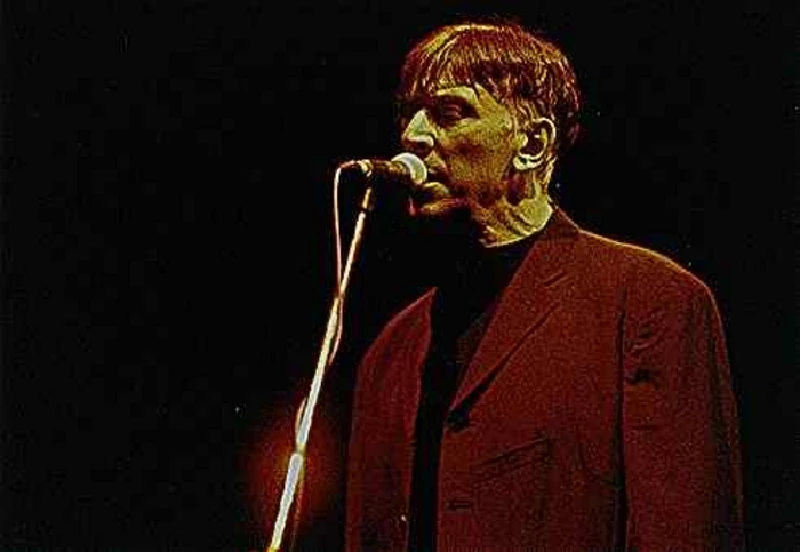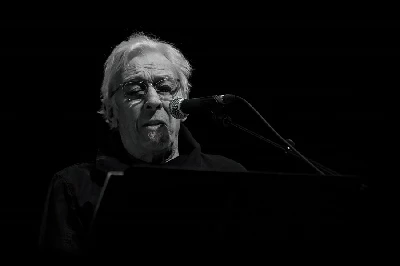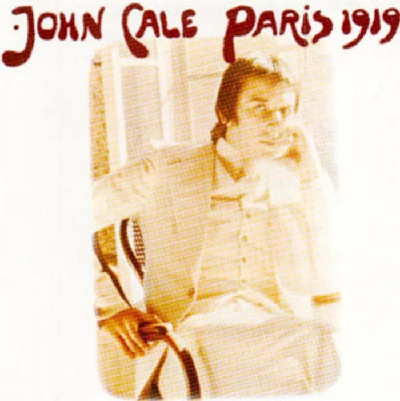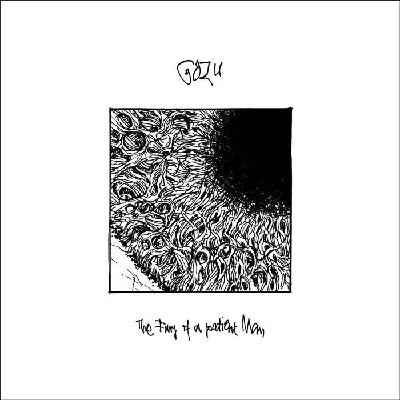John Cale - The Art of Intensity
by John Clarkson
published: 13 / 1 / 2002

intro
It is six years now since John Cale last toured Britain as a solo artist, and it is over five since he got back together with his former bandmates Lou Reed, Moe Tucker and Sterling Morrison for the br
It is six years now since John Cale last toured Britain as a solo artist, and it is over five since he got back together with his former bandmates Lou Reed, Moe Tucker and Sterling Morrison for the brief ‘Velvet Underground’ reformation tour of 1993, which included dates in Edinburgh and London. Cale’s five current British shows are the last in a world tour that has expanded almost a year, and the show at the Glasgow Royal Concert Hall-his only Scottish date -is the penultimate one of the tour, before it will conclude two nights later at the prestigious Royal Festival Hall in London. John Cale has had a recording career that has lasted almost thirty years. His solo work is lesser known that that of Lou Reed, whom he has shared a love-hate relationship with since the mid-sixties. He is an act of whom many rock fans have heard of, but of whom comparatively few in comparision to Reed have heard. Of the two, however, it is Cale, who is perhaps the more diverse and versatile, and at 56, in his fourth decade as a recording act, he remains one of rock’s most experimental and productive musicians. While it was Reed who wrote the lyrics and the songs and was the leader of The Velvet Underground, Cale, a classically-trained Welshman, came up with the arrangements for the group. He was responsible for giving the band its cutting sound and abrasive edge on their first two albums ‘The Velvet Underground and Nico’ and ‘White Light/White Heat’. His solo career began in 1968, after he was fired from the group by a jealous Reed. He has since recorded seventeen solo albums (to my last count, excluding compilations !) that have taken on a mixture of styles including jazz fusion, punk, blues, piano minimalism, classicism, ambience and pop. There have been collaborations too with classicist Terry Riley, Brian Eno and former Bob Dylan sidekick Bob Neuwirth. Cale also got back together with Lou Reed in 1990 to make ‘Songs for Drella’, a tribute to their former Velvet Underground mentor, Andy Warhol . He has written the scores for several film soundtracks also , which include ‘Basquiat’, ‘I Shot Andy Warhol’ and ‘House of America’, and has composed the music for a ballet about the German chanteuse Nico, who worked with The Velvet Underground on their first album. Cale, who Brian Eno has described as’ a fountain of musical ideas’, has also run concurrently a co-career as a producer. His production credits include The Stooges ‘Raw Power’, Patti Smith’s ‘Horses’, four Nico albums including ‘The Marble Index’, and ‘Camera Obscura’, the Modern Lover’s self-titled debut album, Goya Dress’s ‘Rooms’ and the final Siouxsie and the Banshees album ‘The Rapture’. 1999 has started well for Cale. The tour is concluding. His autobiography ‘What’s Welsh for Zen’, co-written with Victor Bockris, who has previously written biographies about Lou Reed, Andy Warhol and Muhammed Ali, has just been published, and a compilation album of some of his best work ‘Close Watch : An Introduction to John Cale’ is also forthcoming. Most of the set tonight is both retrospective and reflective. John Cale, however, like Bob Dylan and Ray Davies of ‘The Kinks’, both of whom he admires, has never been interested in simply reproducing the tested and the familiar on stage, admitting that he would find it boring. He has always chosen to reinterpret his songbook, searching for new structures and adaptions in old meanings . Most of the songs in this set, as in previous sets and tours, have, therefore, gone through radical restructuring , and some tunes, if there were no lyrics to act as guides, would be unrecognisable from their original source. When Cale last came to Britain as a solo act at the tail end of 1992, he had no band and accompanied himself on piano and acoustic guitar, stripping his songs down to their barest and starkest roots, and redefining them with a sparse, and minimalistic interpretation. (The results of this can be heard on his album ‘Fragments of a Rainy Season’) The show tonight could be seen as an upgrading of this. Cale is again on piano and acoustic guitar, but while he is once more not augmented by a full band and the sound of the show often again has a minimalist touch, he has two other musicians with him, Mark Deffenbaugh and Lance Doss. Doss plays lap steel guitar, acoustic guitar and mandolin, and is a veteran of previous European and American tours with him. The multi-faceted Deffenbaugh plays Spanish guitar , flute, harmonica, banjo and Jew’s harp, and has worked with Cale on his last studio album ‘Walking with Locusts’, the soundtrack for the film ‘House of America’ and the Nico ballet. The concert starts abruptly and with a jerk. There is no build-up. The lights of the auditorium drop, and instantly Cale is striding purposefully and intently across the stage towards his grand piano. He looks both elegant and disshevelled, contrasting fading leather trousers and a crumpled beige linen jacket that looks like he has spent the whole tour sleeping in it with, on his feet, a pair of over-sized and gleaming red winkle pickers. Deffenbaugh and Doss, both wearing suits, come onto the stage a few paces behind their boss with almost the same sense of urgency and hastiness. Within what can be no more than a matter of a few seconds from his initial entrance, Cale , with the briefest of nods at his audience, seats himself, mumbling that is good to be in Glasgow, and surges into his first tune, the latest in a long line of Dylan Thomas poems which he has set to music.(I am not sure which one and he doesn't say) The music, backed by Deffenbaugh’s flute and Doss’s lap steel guitar, is discordant and dissonant, and doesn’t get any less tense with Cale’s second offering ‘The Endless Plain of Fortune’. On his third 1973 album ‘Paris 1919’, this song has an orchestral, enrichened feel with a set of strings bringing it to a seering and forceful conclusion. Tonight, however, while there is still a beauty at work, it sounds haunted and unsettling and utterly desolate. The next two songs are further Dylan Thomas adaptations , ‘On a Wedding Anniversary’ and ‘Do Not Gentle into the Good Night’. Both poems are about death. The first is about the death of a couple on their wedding anniversary in what seems to be a bombing. In the second, perhaps Thomas’s most famous poem, the listener is urged to fight against the injustice of death and to ‘rage against the dying of the light’. While Cale has reworked both these tunes for the piano before at the time of ‘Fragments for a Rainy Season’, paring them down off ‘Words for the Dying’, a 1989 Brian Eno produced classical album, in which they were backed by a Moscow symphony orchestra, they tonight have never sounded more fraught or frenzied. The music shifts gears with the next few numbers, becoming less harsh and savage in tone. Songs include a strident ‘Buffalo Ballet’, which Cale introduces as ‘a European vison of a Western’, and the enigmatic ‘Chinese Envoy’ from his 1982 ‘Music for a New Society’ album, which shorn of a harp and strings accompanient, flows with gentle melody. Cale, however, with these tunes too remains as tense as before, hunched and stooped over his piano, his fingers jabbing and hammering at the keys, his shoulders stiff and firmly raised. The silent Deffenbaugh and Doss, sit in semi- darkness on the left side of the stage, slightly away from the main spotlight which hangs over their boss, seemingly equally intent as they wordlessly shift from instrument to instrument. About halfway through the set Cale changes instruments from the piano to the guitar for a few numbers. The always bouyant ‘Ship of Fools’ from Cale’s fourth 1974 solo album ‘Fear’ seems even more feverish and ecstatic than usual, perhaps because so much of the earlier part of the set has been so downbeat.‘Leaving It Up to You’ from the following year’s ‘Helen of Troy’ album, without its usual synthesiser undercurrent , has all three musicians thrashing at guitars at once, the only time during the concert in which they do so. The highlight of this section of is the show is, however, ‘The Ballad of Cable Hogue’, which has gone through one of the most radical reworkings of all the songs in the set. Once more from ‘Helen of Troy’, and inspired by the Sam Peckinpah film of the same name, it once had a lightly strummed guitar base. Cale, however, now sounding disillusioned and sickened as he recounts the song’s violent lyrics, strikes his guitar with a tired weariness and barely at all, while Deffenbaugh plays the same solitary note on his piercing Jew’s harp over and over again. It is not anger or fury which seems to be driving Cale to push himself and his musicians to such extremes. There is none of the tetchiness and grumpiness for which Lou Reed is renowned, who the last time he was in Scotland on the same stage in 1996 spent the whole set glaring at his band and fans and not speaking between numbers, before returning for encores with a lengthy tirade against a journalist who had hacked him off earlier that day. Cale, despite his high state of tension, remains largely good-humoured throughout the set. His clothes alone expose a certain sense of self-ridicule. ‘The Ballad of Cable Hogue’ is introduced with ‘In another life I wish I was Sam Peckinpah’, and much of the rest of his in- between songs talk has a similar dry and self-deprecating wit. On this tour, and on previous tours ,Cale has had a slightly jumpy stage presence. While a fan bellowing out for the obscure ‘Rosegarden Funeral of Sores’ tonight makes him flinch, and a press photographer who moves down the front to take a flashed close-up is given a withering look, it does not seem to be , however, stage fright or nervousness either which is inducing him to these levels. Cale has always said that he has enjoyed playing gigs, and while he has not been to Britain in recent years, he has toured elsewhere regularly, and there have been successful and lengthy tours in America and in other parts of Europe. It seems simply that, to get the most out of himself and his band, he has to push himself to the limits, to totally throw and immerse himself into his music, flexing and gearing himself up as much as possible and to be totally concentrated to give what he believes to be his best possible performance. For the last few numbers Cale returns to the piano. ‘Cordoba’, from ‘Wrong Way Up’, his 1990 collaboration with Brian Eno, has extracted from it the echoing spooky aesthetics and the brief viola interspersions of the original, and has in their place Deffenbaugh’s Spanish guitar and Doss’s lap guitar. ‘Dying on the Vine’ from 1985’s ‘Artificial Intelligence,’ keeps Cale’s strident and reflective vocals, but the moody, fulsome synthesisers of the initial version are, as on ‘Fragments of a Rainy Season’, removed and replaced by the stark, but galloping sound of Cale’s piano. His penultimate number is his sinister and malignant version of ‘Heartbreak Hotel’, which has been a regular feature of his live performances since the mid nineteen seventies, and also appears on his ‘Slow Dazzle’ album. While Elvis on the original is both hurt and world weary, Cale takes a different stance, sounding on the verge of complete and utter mental collapse and like he is going to explode into violence at any moment. Whether it is going be against himself or the woman who has rejected him seems almost optional. The music is thudding and menacing, and Cale, as well as sounding deranged, on stage looks it, his eyes whites in his head, the veins and bones of his face and neck jutting out as his voice lilts upwards towards the high notes. The song reaches a conclusion with Cale working his way with both hands up the arpeggios of the piano, spasmodically pausing between the notes, and finishes, after the longest break of all, as he reaches both the highest and lowest keys. The effect is a simple one, but totally mesmerizing and both unnerving and spellbinding. It would be a dramatic finish to any concert, but Cale, however, has one last trick, a maddened and brief version of the equally scary ‘Fear is a Man’s Best Friend’. He brings the set to a second and final climax, howling the chorus and banging and smashing his fists off the piano, before breaking the song and the set off with a shattering scream. He returns to the stage less than a minute later to play ‘Thoughtless Kind’ as an encore, accompanying himself on the guitar, without his band or the ghostly sound effects of the original. Cale wrote the song about The Velvet Underground for his bleak and despairing ‘Music for a New Society’ album, wanting to remember his tenure with the band, despite its often frequent tensions , as ‘the best of times’. In the light of the death of Sterling Morrison from cancer in 1995 (to whom he has dedicated ‘What’s Welsh for Zen’), and his relationship with Reed which once again has become acrimonious and sour after the reformation tour, the song now has charged meaning, sounding never simpler, or more poignant and bittersweet. Deffenbaugh and Doss come back on stage, and the gig concludes with a rousing, strident version of Leonard Cohen’s ‘Hallelujah’ with Cale back on the piano. It has been a show of extremes, one that has been both dissonant and melodic, but in the whole eighty minutes Cale and his band have been on stage never any the less than enthralling and compelling. Often harrowing and unpredictable, and never easy or relaxing, one has never been quite sure about what is about to come next. The sheer force of Cale and his two musicians has, however, been both binding and exalting. The risks that have been taken with his back catalogue, the regular swopping and change of instruments, and the revitalising of songs with new structures and ideas have made the show absolutely hypnotic and compulsive to watch. As Cale leaves the stage for the last time, waving and blowing a kiss at his audience, and then rushing off with the same sense of urgency that he came on, one is left hoping that it will be soon that this most intense of rock stars and musicians tours again.
Band Links:-
https://john-cale.com/https://www.facebook.com/OfficialJohnCale
https://twitter.com/therealjohncale
live reviews |
|
Philharmonic Hall, Liverpool, 6/2/2023 |

|
| With photos by Andrew Twambley, Paul Kimber finds John Cale still breaking boundaries at the Philharmonic Hall in Liverpool. |
favourite album |
|
Paris 1919 (2006) |

|
| Surprisingly gentle, former Velvet Underground member John Cale's 1973 solo album 'Paris 1919' is a million miles away from his work with the likes of minimalist composer Terry Riley, the experimentation of the Velvet Underground or producing the likes of Patti Smith or the Stooges. Recently re-rele |
reviews |
|
EP: Extra Playful (2011) |

|
| Sparkling new EP from member John Cale which lives up to its title and makes an excellent taster for an album which will be out next year |
most viewed articles
current edition
Carl Ewens - David Bowie 1964 to 1982 On Track: Every Album, Every SongArmory Show - Interview with Richard Jobson
Colin Blunstone - Thalia Hall, Chicago, 16/7/2025
Bathers - Photoscapes 1
Visor Fest - Valencia, Spain, 26/9/2025...27/9/2025
John McKay - Interview
Billie Eilish - O2 Arena, London, 10/7/2025
Robert Forster - Interview
Loft - Interview
Sir Tim Rice - Interview
previous editions
Heavenly - P.U.N.K. Girl EPManic Street Preachers - (Gig of a Lifetime) Millennium Stadium, Cardiff, December 1999
Oasis - Oasis, Earl's Court, London, 1995
Pixies - Ten Songs That Made Me Love...
Beautiful South - Ten Songs That Made Me Love...
Trudie Myerscough-Harris - Interview
Paul Clerehugh - Interview
Doris Brendel - Interview
Prolapse - Interview
Simon Heavisides - Destiny Stopped Screaming: The Life and Times of Adrian Borland
most viewed reviews
current edition
Phew, Erika Kobayashi,, Dieter Moebius - Radium GirlsAmy Macdonald - Is This What You've Been Waiting For?
Sick Man of Europe - The Sick Man of Europe
Davey Woodward - Mumbo in the Jumbo
Cynthia Erivo - I Forgive You
Lucy Spraggan - Other Sides of the Moon
Bush - I Beat Loneliness
Alice Cooper - The Revenge of Alice Cooper
Blueboy - 2
Suzanne Vega - Flying With Angels
Pennyblackmusic Regular Contributors
Adrian Janes
Amanda J. Window
Andrew Twambley
Anthony Dhanendran
Benjamin Howarth
Cila Warncke
Daniel Cressey
Darren Aston
Dastardly
Dave Goodwin
Denzil Watson
Dominic B. Simpson
Eoghan Lyng
Fiona Hutchings
Harry Sherriff
Helen Tipping
Jamie Rowland
John Clarkson
Julie Cruickshank
Kimberly Bright
Lisa Torem
Maarten Schiethart